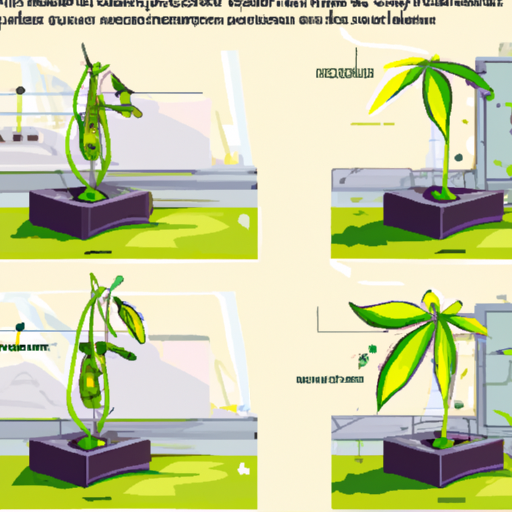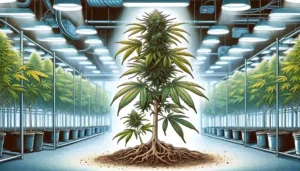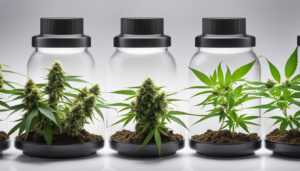This guide offers a comprehensive overview of maximizing yield with cannabis clones through the employment of efficient propagation techniques. By tapping into the vast potential of cloning, growers can significantly enhance their production capabilities. The guide focuses on crucial aspects such as clone selection, environmental conditions, nutritional requirements, and prevention of diseases and pests, among others.
1. Understanding Cannabis Cloning: An Untapped Potential?
Cannabis cloning is a technique that allows growers to replicate and propagate genetically identical cannabis plants. This process involves taking cuttings from a mother plant and encouraging them to develop roots, creating a new plant with the same genetic makeup. Understanding the potential of cannabis cloning is crucial for maximizing yield and efficiency in cultivation.
By utilizing cannabis cloning, growers can bypass the lengthy process of germinating seeds and waiting for them to mature. Instead, they can directly create new plants with desirable traits, such as high yield, potent cannabinoids, or specific flavors. This not only saves time but also ensures consistency in the final product.
Furthermore, cannabis cloning allows growers to preserve the genetics of exceptional plants that have already proven their worth. By cloning these plants, growers can replicate their success and produce a larger quantity of high-quality cannabis. This technique also allows for the preservation of unique and rare strains that may be difficult to obtain through seed germination.
Additionally, cannabis cloning offers the opportunity to maximize yield by selecting the healthiest and most vigorous plants for propagation. By carefully choosing the best clones, growers can ensure that each plant has the potential to produce a bountiful harvest. This strategic selection process is critical for achieving optimal results and consistently high yields.
Moreover, cannabis cloning enables growers to have a continuous supply of plants, ensuring a more efficient cultivation cycle. By maintaining a mother plant and continuously taking cuttings, growers can have a steady stream of plants at various stages of growth. This eliminates the need to start from scratch with seed germination and helps maintain a consistent production schedule.

1. An illustration showing the process of cannabis cloning
2. 'The Best Clone is a Healthy Clone': Choosing the Right Clones
When it comes to maximizing cannabis clone yield and ensuring efficient propagation, selecting the right clones is crucial. The saying "the best clone is a healthy clone" holds true as the health and vigor of the clone directly impact its ability to thrive and produce high yields.
First and foremost, it is important to choose clones from a reputable and reliable source. This ensures that the clones have been properly cared for and are free from any diseases or pests. Taking the time to research and find a trusted clone provider can save growers from potential headaches down the line.
In addition to the source, growers should carefully examine the physical characteristics of the clones before making a selection. Look for clones with vibrant green leaves, strong stems, and well-developed root systems. These visual cues indicate that the clones are healthy and have a higher chance of success during the propagation process.
Another factor to consider is the genetic makeup of the clones. Different cannabis strains have varying growth patterns, yield potentials, and cannabinoid profiles. Growers should choose clones that align with their desired outcomes and cultivation goals. Whether the focus is on high yield, specific flavors, or potent cannabinoids, selecting clones with the desired genetic traits is essential for maximizing yield and achieving the desired end product.
Furthermore, it is advisable to choose clones that are in the vegetative stage rather than those that have already started flowering. Vegetative clones have a longer period for growth and development before transitioning into the flowering stage. This allows growers to have more control over the plants' growth and maximize their potential yield.
3. Creating the Ideal Environment: Is It More Important Than You Think?
Creating the ideal environment for cannabis clone propagation is a crucial factor that often receives less attention than it deserves. However, it can greatly impact the success and yield of the clones. To ensure efficient propagation and maximize yield, growers should pay close attention to factors such as temperature, humidity, and lighting.
- 1. Temperature:
Maintaining the right temperature is essential for the healthy growth and development of cannabis clones. The ideal temperature range for clone propagation is typically between 70-80°F (21-27°C). This temperature range promotes root development and minimizes stress on the clones. It is important to monitor and regulate the temperature consistently throughout the propagation process to provide optimal conditions for the clones. - 2. Humidity:
Proper humidity levels are crucial for successful clone propagation. In the early stages, higher humidity levels of around 70-80% help clones retain moisture and reduce stress. As the clones develop roots and acclimate to their environment, gradually reducing humidity to around 50-60% is recommended. This helps prevent issues such as mold or excessive moisture, which can hinder growth and yield. Using a humidifier and dehumidifier, along with regular monitoring, can help maintain the ideal humidity levels. - 3. Lighting:
Providing adequate and appropriate lighting is vital for the healthy growth of cannabis clones. During the propagation stage, fluorescent lights or LED grow lights are commonly used. These lights offer the right spectrum and intensity for clone development without excessive heat that could stress the plants. It is important to position the lights at an appropriate distance to ensure sufficient light coverage and prevent light burn. Maintaining a consistent light cycle of 18-24 hours of light per day promotes vigorous growth and root development.

3. Image of an optimal cloning environment setup
4. Nutritional Requirements: The Building Blocks of High Yielding Clones
Proper nutrition is essential for the development and growth of high-yielding cannabis clones. Providing the right balance of nutrients ensures that the clones have the necessary building blocks to thrive and produce abundant yields. There are several key nutrients that play crucial roles in clone development, including nitrogen (N), phosphorus (P), potassium (K), calcium (Ca), and magnesium (Mg).
Nitrogen is important for overall plant growth and development, especially during the vegetative stage. It supports the production of chlorophyll, which is essential for photosynthesis and energy production. Phosphorus is vital for root development, flowering, and fruiting, making it crucial during the early stages of clone propagation. Potassium helps with water and nutrient uptake, enzyme activation, and overall plant health.
Calcium and magnesium are secondary macronutrients that are also vital for cannabis clone development. Calcium plays a crucial role in cell wall development, ensuring strong and healthy plant structures. Magnesium is a key component of chlorophyll and is involved in photosynthesis, as well as enzyme activation.
To meet the nutritional requirements of cannabis clones, growers can use a combination of organic and synthetic fertilizers. It is important to choose fertilizers specifically formulated for cannabis cultivation, as they will provide the appropriate nutrient ratios and avoid nutrient deficiencies or toxicities. Additionally, monitoring the pH levels of the nutrient solution is crucial, as it affects nutrient uptake. Maintaining a pH range of 5.5-6.5 ensures optimal nutrient availability to the clones.
Regular monitoring and adjustment of nutrient levels are essential throughout the propagation process. As the clones grow and develop, their nutritional needs may change. Adjusting nutrient concentrations and ratios accordingly helps prevent deficiencies or excesses, ensuring healthy and high-yielding clones.
5. 'Prevention is Better Than Cure': Mitigating Risks of Diseases and Pests
Diseases and pests can wreak havoc on cannabis clones, leading to stunted growth, reduced yields, and even plant death. As the saying goes, "prevention is better than cure," and this holds true when it comes to protecting your clones from these potential threats.
One of the most effective ways to mitigate the risks of diseases and pests is to maintain a clean and sanitized growing environment. Regularly clean and disinfect all equipment, tools, and surfaces to prevent the spread of pathogens. This includes trays, pots, and any other materials that come into contact with the clones.
Implementing strict hygiene practices is also crucial. Avoid cross-contamination by washing your hands thoroughly and changing gloves before handling different plants or clones. Additionally, it is important to ensure that any new clones brought into the growing area are free from pests and diseases. Quarantining new arrivals for a period of time and closely inspecting them before introducing them to the rest of the clones helps prevent the introduction of potential threats.
Furthermore, maintaining optimal environmental conditions can also play a significant role in preventing diseases and pests. Proper ventilation and airflow help reduce humidity levels, minimizing the risk of mold and fungal diseases. Controlling temperature and humidity levels within the recommended ranges also create an environment that is less favorable for pests.
Regular scouting and monitoring of the plants are essential to catch any signs of diseases or pests early on. Timely detection allows for swift action, reducing the potential impact on the clones. Consider implementing integrated pest management (IPM) strategies, which focus on prevention, biological controls, and minimal pesticide use. This approach promotes a healthy and balanced ecosystem while minimizing the risks associated with chemical treatments.
7. Monitoring and Adjustments: Are You Giving Your Clones What They Need?
Monitoring and making necessary adjustments are crucial aspects of maximizing yield with cannabis clones. By closely observing the clones and their growth, growers can ensure that they are providing the optimal conditions and addressing any potential issues promptly.
1. Regular Monitoring for Growth and Health:
Keeping a close eye on the clones' growth and overall health is essential. Monitor factors such as leaf color, size, and shape, as well as stem thickness and overall vigor. Any signs of yellowing, wilting, or stunted growth should be noted and investigated further. Regular monitoring allows growers to identify any potential problems early on and take corrective actions to prevent further damage.
- 2. Adjusting Nutritional Requirements:
As clones grow, their nutritional needs change. It is important to regularly assess and adjust the nutrient levels accordingly. Conduct regular soil or hydroponic solution tests to measure pH levels and nutrient concentrations. Adjusting the nutrient solution composition based on these measurements ensures that the clones are receiving the right balance of essential elements for optimal growth and yield. - 3. Environmental Adjustments:
Environmental conditions play a vital role in the development of cannabis clones. Monitoring factors such as temperature, humidity, light intensity, and CO2 levels is crucial. Adjustments may be necessary to maintain the ideal conditions for clone growth. For example, if the temperature is too high, it may be necessary to introduce additional ventilation or cooling measures. Similarly, if the humidity levels are too low, using a humidifier can help create a more suitable environment. Regularly monitoring and adjusting these environmental factors ensures that the clones are provided with the best possible conditions for growth and yield.
Maximizing Yield with Cannabis Clones:
| Propagation Technique | Environment | Nutrition | Health |
|---|---|---|---|
| Clone Selection | Optimum Conditions | Nutritional Requirements | Disease/Pest Prevention |
| Temperature Regulation | Lighting/Humidity Levels | Soilless/Organic Mediums | Fungal/Insect Control |
| Root Pruning | Airflow/Ventilation | Nutrient Schedules | Organic Pesticides |
| Vessels/Equipment | Sterilization | Monitoring pH Levels | Herbal Remedies |
In conclusion, maximizing cannabis clone yield is a result of strategic planning and careful implementation of effective propagation techniques. It is a combination of choosing the right clones, creating an optimal environment, providing adequate nutrition, and mitigating potential risks. Although it may seem complex initially, with appropriate knowledge and skills, growers can achieve high yields consistently.





